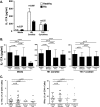Rheumatoid arthritis patients exhibit impaired Candida albicans-specific Th17 responses
- PMID: 24513269
- PMCID: PMC3978747
- DOI: 10.1186/ar4480
Rheumatoid arthritis patients exhibit impaired Candida albicans-specific Th17 responses
Abstract
Introduction: Accumulating data implicate the CD4+ T cell subset (Th17 cells) in rheumatoid arthritis (RA). IL-17 is an inflammatory cytokine that induces tumor necrosis factor (TNF)α, IL-1β and IL-6, all of which are targets of biologic therapies used to treat RA. RA patients are well documented to experience more infections than age-matched controls, and biologic therapies further increase the risk of infection. The Th17/IL-17 axis is vital for immunity to fungi, especially the commensal fungus Candida albicans. Therefore, we were prompted to examine the relationship between RA and susceptibility to C. albicans because of the increasing interest in Th17 cells and IL-17 in driving autoimmunity, and the advent of new biologics that target this pathway.
Methods: We analyzed peripheral blood and saliva from 48 RA and 33 healthy control subjects. To assess C. albicans-specific Th17 responses, PBMCs were co-cultured with heat-killed C. albicans extract, and IL-17A levels in conditioned supernatants were measured by ELISA. The frequency of Th17 and Th1 cells was determined by flow cytometry. As a measure of IL-17A-mediated effector responses, we evaluated C. albicans colonization rates in the oral cavity, salivary fungicidal activity and levels of the antimicrobial peptide β-defensin 2 (BD2) in saliva.
Results: Compared to controls, PBMCs from RA subjects exhibited elevated baseline production of IL-17A (P = 0.004), although they had similar capacity to produce IL-17A in response to Th17 cell differentiating cytokines (P = 0.91). However RA PBMCs secreted less IL-17A in response to C. albicans antigens (P = 0.006). Significantly more RA patients were colonized with C. albicans in the oral cavity than healthy subjects (P = 0.02). Concomitantly, RA saliva had reduced concentrations of salivary BD2 (P = 0.02). Nonetheless, salivary fungicidal activity was preserved in RA subjects (P = 0.70).
Conclusions: RA subjects exhibit detectable impairments in oral immune responses to C. albicans, a strongly Th17-dependent opportunistic pathogen, despite an overall elevated baseline production of IL-17A.
Figures



References
-
- Zaba LC, Cardinale I, Gilleaudeau P, Sullivan-Whalen M, Suarez Farinas M, Fuentes-Duculan J, Novitskaya I, Khatcherian A, Bluth MJ, Lowes MA, Krueger JG. Amelioration of epidermal hyperplasia by TNF inhibition is associated with reduced Th17 responses. J Exp Med. 2007;16:3183–3194. doi: 10.1084/jem.20071094. - DOI - PMC - PubMed
Publication types
MeSH terms
Grants and funding
LinkOut - more resources
Full Text Sources
Other Literature Sources
Medical
Research Materials

